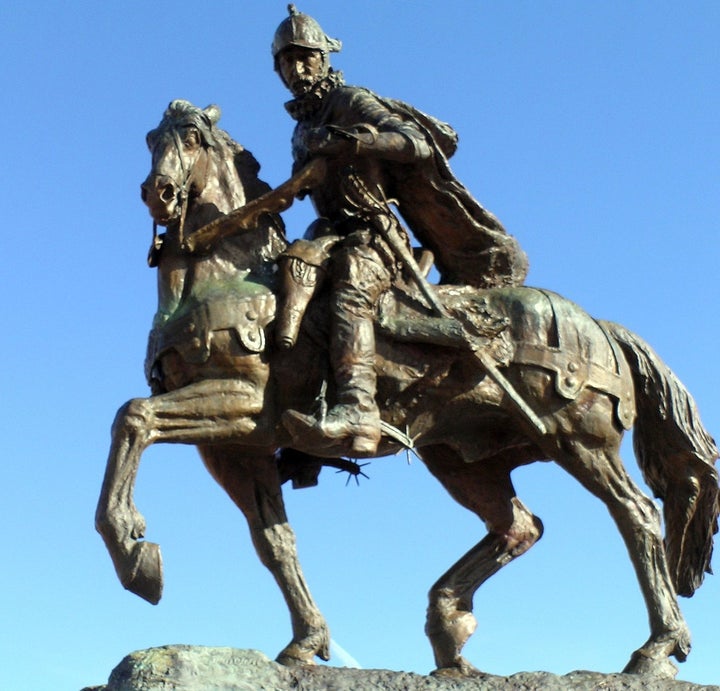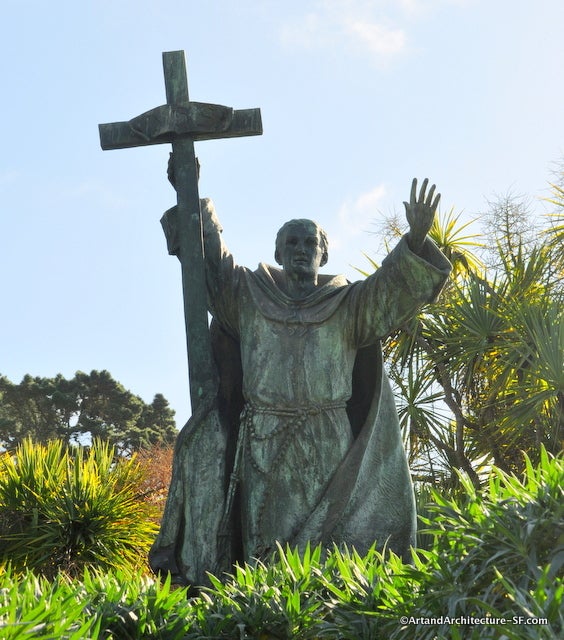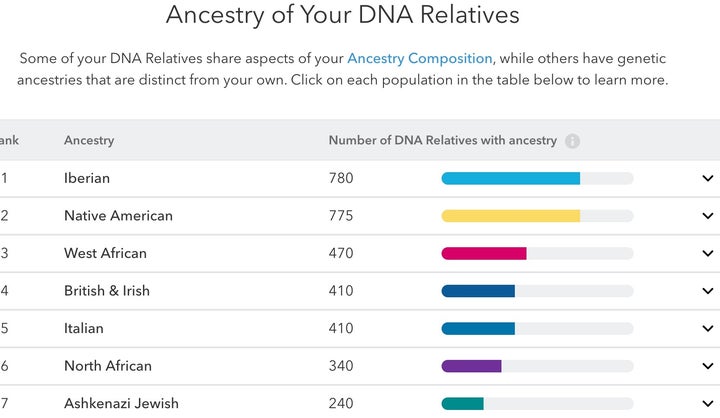
Oñate Monument, Oñate Monument Center (Alcalde, New Mexico)Equestrian statue photo by Advanced Source Productions, licensed CC-By-2.0
Since around November of last year, I’ve been trying to understand what it might mean to refer to a “white culture.” In the last few weeks, it’s easy to jump to conclusions about their ideas about Nazism, slavery, and fascism. Yet, some people protesting the removal of confederate statues and supporting the “alt-right” have attempted to disconnect their motivations from racism. One of the protesters blogged that the heart of the matter was “white culture.” Another of the white pride protestors in Charlottesville, Peter Cvjetanovic, claimed that the purpose of the march was to assert Europeans’ rights to be in the United States.
The debate about removing monuments in the name of whiteness shows that many Americans don’t understand the basic premise of ancestry. Also, this seems an appropriate time to once again highlight how racial categories are not based in biology. As an important social construction, race is always specific to geographic and historical contexts. Public memorials, commemorative art, and statues help us see how communities create their public histories. As I tried to understand the events in Virginia last week, I can’t help but approach them from my own experience in the other South, the U.S. Southwest.
After centuries of moving around, and most of our ancestors having sex, we shouldn’t be surprised that so many people are not able to trace their ancestry to one particular group. We are slowly becoming mutts, as some have stated elsewhere. It seems that the evolution of homo sapiens is starting to upset some white nationalists, making the Scientific American look like a Jerry Springer show. There and other outlets have been describing how white nationalists don’t understand genetics and DNA. Perhaps what we see, then, while watching young men and women take to the streets to oppose the removal of confederate statues is a tangible fear of not having an identity. Their marching seems a sign of fragility. But by their fetishizing an object, such as a statue, perhaps we’re seeing the most obvious form of whiteness, valuing things over people.
By marching in the streets with armed militia about these public memorials, the alt-right are asserting that the memory of whiteness is under threat. I guess they haven’t picked up many history books, turned on the TV, or looked at their country’s leadership. Which of these focal points don’t express a narrative of Europeans as the central actors in a worldwide story of progress from “dark” ages and “dark” continents, bringing enlightenment to savage lands through capitalist modes of extraction?
On the other hand, when I see well-intentioned progressives arguing for the Confederate statues to come down, I am happy to see us on this slippery slope. It’s a fine time for states, cities, and schools to ask themselves what and who they choose to commemorate.
What we call “American culture” is a projection of European fantasy. The fantasy started by calling the hundreds and hundreds of tribes one name, “Indians,” and then proceeding to stamp out their languages, governments, territorial rights, rituals, and food ways. If the leaders of the confederacy shouldn’t be memorialized, what about those colonizers and missionaries who tried to stamp out Native people’s cultures? That process did not come to full fruition of course. But if we want to make public spaces safe for everyone, our collective sites of memory should reach farther back than the Civil War.
Since I have never lived in “the south,” nor spent considerable amount of time there, I will not dwell on the Southern states. I was born and raised in New Mexico, went to college in Arizona, and now live in California. Like most states, the Western States include many American Indian communities. Those tribal members, young and old, drive on streets named after people who sought to extinguish their ancestors. Across the U.S. Southwest, Native American kids go to schools named after conquistadors and missionaries who displaced their ancestors and often sought the end to their culture.

Father Junipero Serra by Douglas Tilden, Golden Gate State Park
So while we’re removing the monuments to violent oppressors, let’s include Junipero Serra, Francisco Coronado, and Juan de Onate. (We also have a confederate memorial near Los Angeles, but like many others it has more to do with late 20th century racism than southern independence since it was built in 2004). Serra oversaw a campaign of brutality and slave labor. Coronado attacked several Native communities, including Zuni. Juan de Onate was convicted for his leading the Acoma massacre and other atrocities. Their statutes still stand, as do many other sites of memory. Surely the memories are about more than whiteness.
In New Mexico, for example, “white” meant Spanish on birth, marriage, and death certificates. Those white Spanish families did not speak “English only,” since most of them had settled not in the United States, but rather in the northern frontier of Mexico. Their culture was one of oppositional squatting. They were competing with ranchers from the East who wanted their land for cattle grazing, prospecting, and farming. They fought various indigenous groups in order to stay settled. They knew who they were by who they were not, and by hopes of recreating a Spanish caste system in their new land, freshly stolen from Indians. They used religious conversion to help in the “civilizing” process.
That’s one of the conundrums of growing up in the U.S. Southwest. Many of us from that area have Spanish blood, but grew up in Mexican culture. Some Mexicans consider themselves indigenous too. And some indigenous people attend Christian, evangelical, protestant, and Catholic churches. Moreover, as my own bloodline and oral history attest, some Spanish, Mexican, and Indigenous communities sold, bought, captured, adopted, married, raped, and had consensual sex with people from other communities.
Trying to empathize with white nationalists, I guess I could say that the Spanish conquistadors and missionaries made my current life possible. And maybe white nationalists think that their existence, freedom, and culture can be traced back to the acts of these historic figures now cast in stone and metal. But as with the Spaniards, their way of life entailed the subjugation of others. If their cultures and religions continued, they mostly did so by forced conversion. Some might see heroic acts of exploration and bravery; but others are standing in the statues’ shadows of attempted genocide.
The basic reason that “white culture” should not be memorialized is that it does not exist. White nationalism has no basis in biology. That’s why ancestry tests are making the news again this week. The haplogroups researched by ancestry tests (in my case below, 23andme) are literally provided to tell you about the “. . . the origins of some of our ancestors and on their migrations over tens of thousands of years.” The influences are Iberian (a geographic region), not the country of Spain. The influences are Indigenous to the Americas and South Asia, not Apache or Comanche (specific nations). Ancestry from current day Britain is not the same as being British. Thus, the ancestry tests have little relevance to current nation-states.

23andMe Report of author’s DNA Relatives
America was an invention, built upon the theft of indigenous property. Like the blood coursing through our veins, we will not find a “pure” America, nor a “white” America. The indigenous people have never not been here during the formation of the current nation state. White culture in Southwestern USA, is like elsewhere in the country: mixed.
The statues celebrating the lives of confederates are no more or less atrocious as those commemorating the conquistadors, and even many missionaries. We are in an opportune moment to take these small steps toward reconciling the past by renaming schools, mountains, and streets. We should also think about the symbolic violence of certain mascots. However pluralistic and egalitarian we hope this country to be, we will fail if Indigenous peoples and experiences are ignored.
